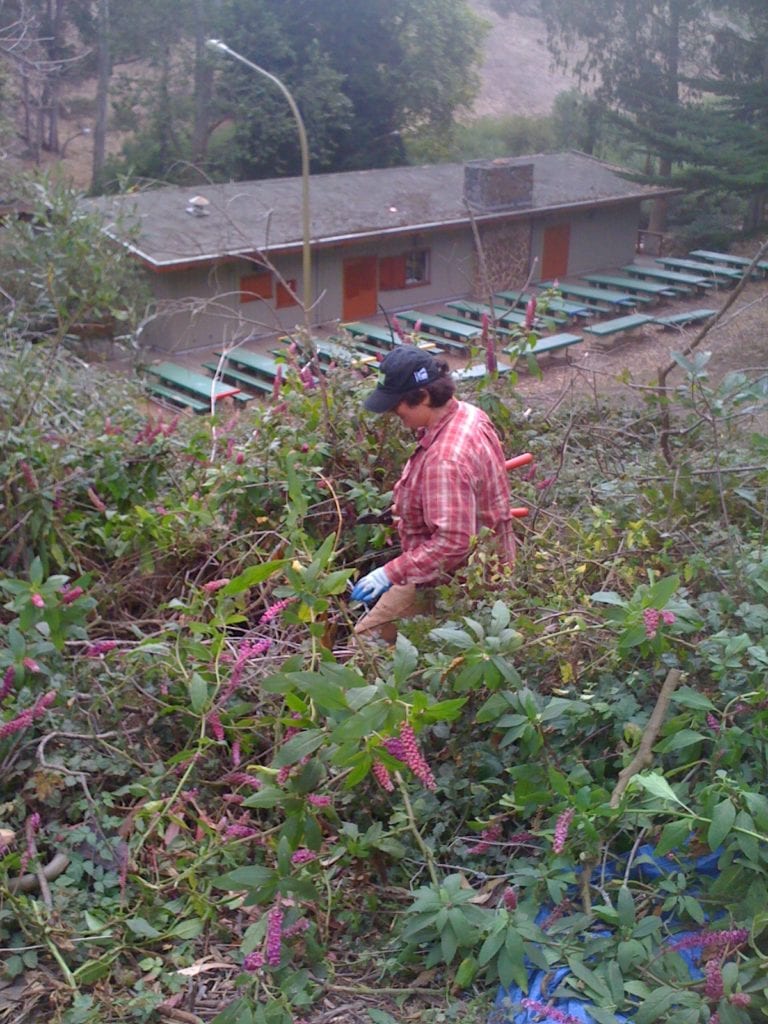
By Murray Schneider
The Glen Park volunteers had already spent two hours Wednesday morning using three-pronged rakes or unraveled by hand hundreds of invasive Cape ivy tendrils. Enthusiasm undiminished, Recreation and Parks Natural Areas Program manager Rachel Kesel checked her watch and told the group “I think we still have time to pull pokeweed.”
Kesel comes from Georgia and is familiar with the native shrub that originated in her neck of the woods. While the jury is out as to whether it’s a bane or a blessing, clumped together in sheaves of gawky and rangy leaves that boast purple berries, pokeweed presents a colonizing threat to canyon habitat, which include California blackberry and a number of California native plants.
“We used to eat it back home,” said Kesel, about a bush that birds consume as well, torpedoing meteor showers of purple poop into Appalachian hollows and onto Smoky Mountain ridges. A staple of Southern cuisine, pokeweed is a side dish, steamed or parboiled, tasting better when it’s young and tender before berries develop. While it is sweeter than spinach, it’s poisonous unless the roots are carefully washed, and can act as a violent emetic, a toxic threat to both dogs and children. Glen Canyon boasts lots of dogs and children, which is why Kesel began weeding it with alacrity.
Kesel waded into a labyrinth of blackberry, having no difficulty locating the pokeweed, conspicuous as it signaled itself with flags of purple exclamation marks. Used as an ornamental plant in home gardens, one or two strands of the plant are decorative, but clumped together, thickets of pokeweed are bushy barriers that inhibit any sort of pedestrian traffic.
Nearly hidden by the vegetation, Kesel wielded a lopper, cutting branches and piling each atop a blue tarp. She wore gloves because the purple berries stain and the juices play havoc with one’s hands. Hilltop mountaineers once used the crushed berry as ink, but it wasn’t colorfast so it would fade. As hard as it is to imagine, the United States Constitution was written with pokeberry ink. The Cherokees continued making use of pokeberry decades after the 1787 Constitutional Convention, using it to stain feathers and dye clothing they obtained from Scotch-Irish Blue Ridge Mountain traders.
Gloria Koch, another volunteer, collected a lopper and plowed into the copse, standing shoulder-to-shoulder with Kesel. For a while they both remained immersed in braids of purple and green leaves and berries. Another volunteer, a retired high school teacher, stood above them, winnowing limbs with another lopper so that the growing pile could become more manageable and easier to haul to the NAP truck.

How did an Eastern Tennessee and Western North Carolina native plant make its way across a continent and find fertile soil in Glen Canyon? That’s anyone’s guess, but undoubtedly migrating birds or possibly prevailing westerly winds may have had something to do with it, maybe even a Glen Park villager who walked the Appalachian Trail and returned with a seed or two on the sole of his or her hiking boots.

Recently retired from Rec and Parks after a 28-year career as a City gardener, Koch can’t get enough of this sort of work, finding it difficult to wean herself from the open air. Kesel and Koch, who lives on Diamond Street, grabbed a tarp loaded with pokeweed and hefted it a few feet above the trail. They walked it to the truck and slung it on the flatbed. “I need the outdoors,” Koch said, shoveling the pokeweed away from NAP stockpiled tools and then reaching for a thermos of water sitting on the truck’s gate.
Anyone wishing to become a Natural Areas Program volunteer in Glen Canyon Park can contact Joe Grey at 415-831-6328 or e-mail him at joe.grey@sfgov.org.
